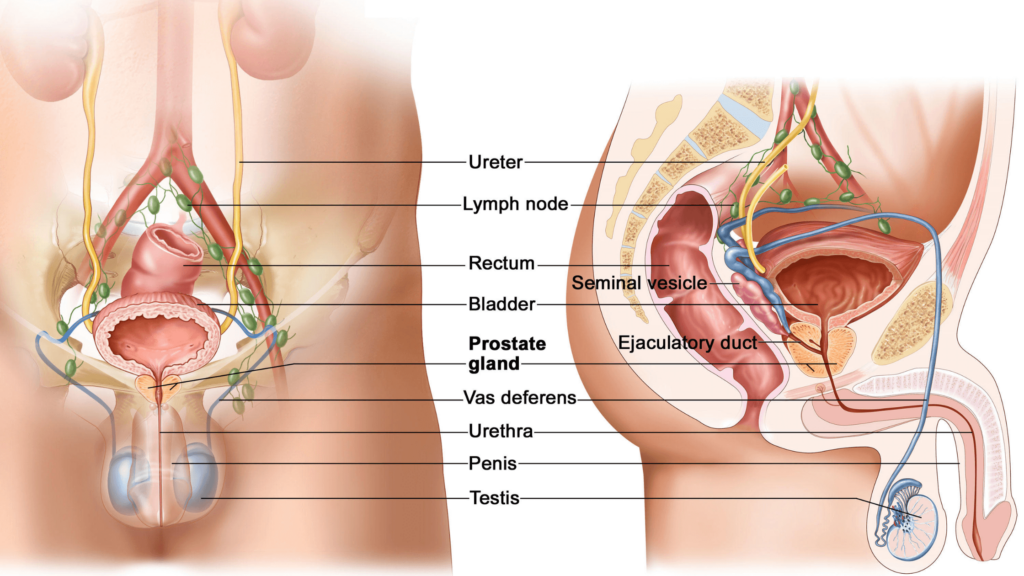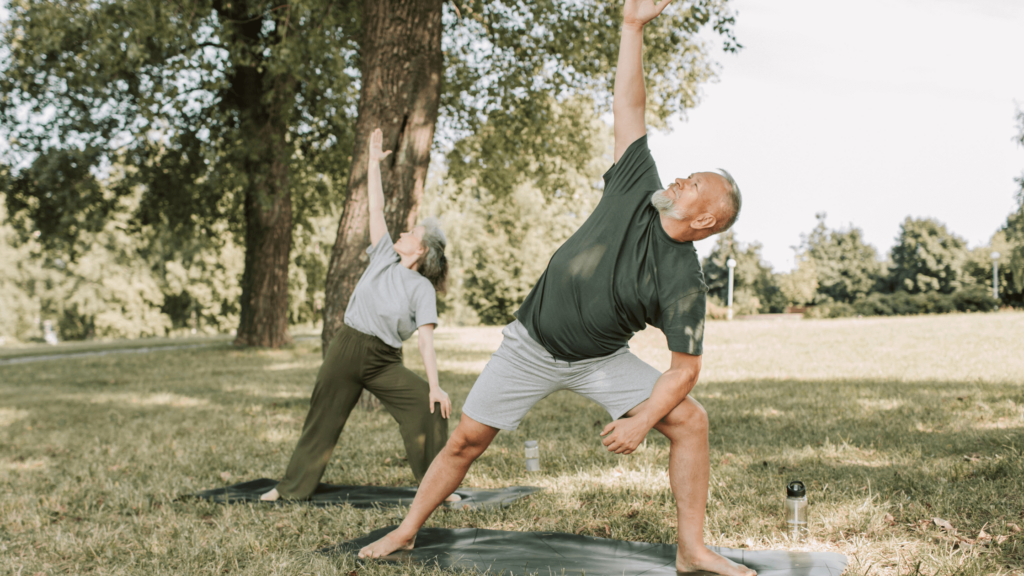The prostate is a small gland located beneath the bladder that’s partly responsible for producing the fluid that makes up semen. The prostate naturally grows with age, but an enlarged prostate can lead to issues with urination, pain, and discomfort. The risk of prostate cancer in men is relatively high, so regular checkups, maintaining a healthy weight, and eating clean are easy ways to keep your prostate healthy and reduce your risk of prostate cancer and other prostate conditions.
Quick look
- What is the prostate
- Prevalence of prostate cancer in men
- Symptoms of enlarged
- Causes of enlarged prostate
- Enlarged prostate symptoms
- Construction work and prostate cancer
The prostate is a small chestnut-sized gland
The prostate is a small gland that’s part of the male reproductive system. It is located just beneath the bladder and above the pelvic floor muscles. The prostate gland ducts flow into the urethra, which passes through the prostate.

The prostate produces the fluid that, together with sperm cells from the testicles and fluids from other glands, makes up semen. The prostate muscles also make sure that semen is forcefully pressed into the urethra and then expelled during ejaculation.
It also plays a role in:
- Closing of the urethra up to the bladder during ejaculation
- Closing of the seminal ducts during urination
- Hormone metabolism (testosterone is converted to its biologically active form, DHT)
The prostate goes through two main periods of growth—the first during puberty, when the prostate doubles in size, and the second around 25, where it continues to grow during most of a man’s life.
Enlarged prostates, referred to as benign prostatic hyperplasia (BPH), are relatively common and not always a cause for concern. Rates increase with advancing age, and research suggests that the histological prevalence of BPH is as high as 50% to 60% for males in their 60s, rising to 80% to 90% of those older than 70.
BPH is a condition whereby the prostate is enlarged but not cancerous. An enlarged prostate presses against and pinches the urethra. This results in urethral compression and obstructed bladder outflow, which can eventually lead to lower urinary tract symptoms (LUTS), urinary retention, or infections due to incomplete bladder emptying.
For most men, this can be problematic for many reasons, the most obvious being impotence or incontinence issues.
But it’s important to remember that just because the prostate is enlarged does not mean it’s cancerous—and that’s only one reason why all men should be aware of maintaining good prostate health.
Prostate cancer prevalence is high
Apart from BPH, prostate cancer is another biggie that men need to know about when it comes to prostate health.
The risk of prostate cancer varies based on a man’s age, race, lifestyle, and even occupation since some jobs have a higher risk of this disease. Statistics from the American Cancer Society estimate that 1 in 8 men will be diagnosed with prostate cancer in their lifetime. It’s also the second most common cancer in men worldwide.
That means that on a job site of 80 people, ten will have prostate cancer.
The average age of men when first diagnosed with prostate cancer is 67, but the risk is higher in African American and Caribbean African men, though it’s not entirely clear why. Some sources suggest diet and lifestyle factors may contribute.
Prostate cancer treatment is widely available, and survival rates are high—in Canada, the 5-year net survival for prostate cancer is 91%, meaning about 91% of men diagnosed with prostate cancer will live for at least five years following diagnosis and treatment. In the US, that stat is slightly higher, with the 5-year survival rate at 97% and the 10-year relative survival rate at 98%.
Here’s the important part: the key to beating cancer is early detection. Cancer survival rates are much higher when metastasis hasn’t occurred.
Enlarged prostate symptoms
Because the prostate gland is located just below the bladder, an enlarged prostate can interfere with the urethra and, therefore, urination. Pressure from an enlarged prostate can block the flow of urine and semen and cause irritation. For men who have developed BPD, any of the following symptoms may occur:
- Weak or interrupted urine flow
- Trouble starting urination
- Sudden urgency to urinate
- Frequent urination
- Inability to empty the bladder
- Dribbling at the end of urination
- Urinary incontinence
- Pain after ejaculation or during urination
- Urine that has an unusual color or smell
It’s important to remember that the prostate’s size isn’t the be-all-end-all—the position of the prostate relative to the urethra is more important than its actual size. But if you notice any symptoms of an enlarged prostate, speak to your doctor about an examination.
Prostatitis is another common issue that occurs in men under 50. It’s a painful and uncomfortable condition caused by inflammation of the prostate and sometimes the areas around the prostate. It’s the most common urinary tract problem in men under 50 and the third most common urinary tract problem for men older than 50.
The primary symptoms of chronic prostatitis/chronic pelvic pain syndrome include pain or discomfort lasting three or more months in one or more of the following areas:
- Between the scrotum and anus
- The central lower abdomen
- The penis
- The scrotum
- The lower back
- Pain during or after ejaculation
Other symptoms of chronic prostatitis include:
- Pain in the urethra during or after urination
- Pain in the penis during or after urination
- Frequent urination (8 or more times a day)
- Increased urinary urgency
- Weak or interrupted urine stream
Acute bacterial prostatitis symptoms appear suddenly and are severe, meaning immediate medical attention is crucial. Symptoms of acute bacterial prostatitis may include:
- Frequent urination
- Urinary urgency
- Fever
- Chills
- Burning or pain during urination
- Pain in the genital area, groin, lower abdomen, or lower back
- Frequent urination during periods of sleep (nocturia)
- Nausea and vomiting
- Body aches
- Urinary retention
- Difficulty starting a urine stream
- Weak or interrupted urine stream
- Urinary blockage (inability to urinate)
- UTI
Chronic bacterial prostatitis symptoms are similar to acute ones but often not as severe. This type of prostatitis typically develops slower and can last three or more months, with symptoms coming and going, or mild all the time. Common symptoms of chronic bacterial prostatitis may include:
- Urinary frequency
- Urinary urgency
- Burning feeling or pain during urination
- Pain in the genital area, groin, lower abdomen, or lower back
- Frequent urination during periods of sleep (nocturia)
- Painful ejaculation
- Urinary retention
- Difficulty starting a urine stream
- Weak or interrupted urine stream
- Urinary blockage
- UTI
After you turn 40, speak regularly with your physician about your prostate health. Also, be sure to schedule regular checkups with your healthcare practitioner.
Causes of an enlarged prostate
Doctors aren’t sure why the prostate begins to grow after men hit a certain age, but it’s been speculated that excess hormones might be the culprit. Some research has found a correlation between high dihydrotestosterone (DHT) levels in the blood and enlarged prostates, but other evidence shows a potential link to aging and changes in the cells of the testicles.
Put simply, researchers aren’t sure of the specifics of why BPH happens, but certain diet and lifestyle factors may contribute. What they do know is that men who have had their scrotums removed due to something like testicular cancer don’t have enlarged prostates.
There also are links between higher estrogen levels and prostate cancer. Testosterone levels naturally decline as men age, which changes the relative proportions of estrogen and testosterone in the bloodstream. Higher levels of estrogen are a documented marker for prostate cancer.
Risk factors for prostate cancer
As with most cancers, prostate cancer is hereditary—but your genes aren’t the only thing that determines your risk. Construction workers, specifically, are subject to environmental, physical, and stress-related factors that can put them at a higher risk of developing prostate cancer.
One Canadian study of about 35,000 prostate cancer cases among workers found a higher risk in men employed in management/administration, teaching, transportation, construction, firefighting, and police work. What’s apparent from the data is that stress could be a risk factor for this disease, given that most of these professions could be considered high-stress.
Researchers have identified the need to assess job-specific exposures related to prostate cancer, including sedentary behavior, stress, and shift work. However, certain things are known to be related to cancer risk, including a family history of prostate cancer, being overweight or obese, smoking, eating processed and/or red meat or high saturated fat intake, low physical activity, and stress.
One study on job-related risk factors for prostate cancer found that exposure to certain chemicals likely plays a part. The study identified possible risk factors for prostate cancer, including exposure to:
- Pesticides
- Cadmium
- Chromium
- Polycyclic aromatic hydrocarbons (PAH)
- Cutting fluids
- Diesel fumes
- Metal fabrication
- Metal dust
- Rubber
- Ionizing radiation
Tips to maintain a healthy prostate
Lose extra pounds
Being overweight or obese is a risk factor for several types of cancer, including prostate cancer. Research shows that obesity is linked to several hormonal changes, many of which have been implicated in prostate cancer development and progression. To maintain a healthy prostate, you need to lose extra weight.
Clean up your diet

Diet plays a huge part in disease risk, and cleaning up your diet—removing excess sugar, processed foods, high saturated fat, etc.—can profoundly impact your overall health. But when choosing the right foods to eat, consider the Mediterranean diet. Studies have shown that men who stick to a predominantly Mediterranean diet have a lower risk of being diagnosed with prostate cancer but also a higher chance of recovery if they have prostate cancer and are undergoing radiation treatment.
The Mediterranean diet is a style of eating based on the traditional eating patterns of people living in Greece, Italy, South of France, and some Middle Eastern countries. It doesn’t restrict fat or carbohydrates but focuses on consuming whole foods in their most natural form. That means cutting back on processed and refined foods and filling your plate mostly with antioxidant-rich fruits and vegetables, whole grains, legumes, and healthy fats from olive oil, nuts, and fish.
Quit smoking
Smoking is one of the top contributors to lung cancer, but it’s also linked to a host of other cancers due to its effect on circulating hormone levels and exposure to carcinogens. While the link between smoking and prostate cancer isn’t completely clear, some researchers suggest that some cancerous pollutants inhaled from cigarettes are excreted in urine, which flows through the prostate. As such, there’s the potential for smoking to increase levels of toxic inflammation, thereby heightening the risk of cancer.
Get physically active

It’s clear that regular physical activity has benefits for overall health, but there’s abundant research backing the role of physical activity in prostate cancer prevention. A recent systematic review and meta-analysis found a “30% risk reduction for prostate cancer mortality and a 40% risk reduction for all-cause mortality for the most vs. least active prostate cancer survivors.” But it’s not just about moving your body—it’s also about the weight loss that comes with regular exercise.
Whether you play basketball, go for a run, or lift weights, regular physical activity helps control your weight and inflammation levels.
Consider taking a prostate supplement
Supplements aren’t intended to replace a healthy diet, but they can be a great compliment to one. Natural supplements like lycopene (found in cooked tomatoes), saw palmetto, boron, pumpkin seed oil, and beta-sitosterol are research-backed natural supplements for improving prostate health. Be sure to speak with your healthcare professional before starting any new supplements.
Know your risk
A family history of prostate cancer increases your risk, as does working in a high-stress environment like construction. If you’re in a high-risk group for developing prostate cancer, consider getting screened starting at age 40. Men at normal risk are encouraged to consider screenings beginning at age 55.
Bottom line
The health of your prostate is just as vital as any other organ in your body. While construction workers are known to be at a higher risk for cardiovascular complications, heart health shouldn’t be the only priority.
Cleaning up your diet, maintaining a healthy weight, being physically active outside of work, and getting regular checkups are simple ways to keep your health and reduce your risk of developing prostate problems.


